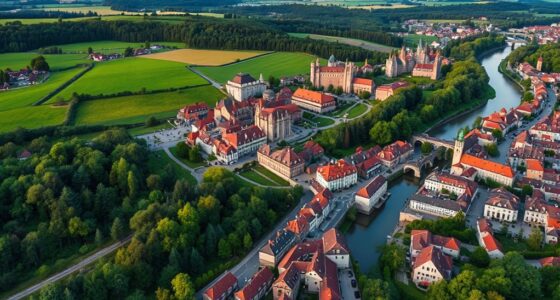Luxembourg’s history begins with its founding in 963 on a strategic rocky hill, evolving into a powerful medieval fortress under the House of Luxembourg. Its location at Europe’s crossroads shaped its culture, with landmarks like the Adolphe Bridge symbolizing resilience. The country faced occupations during the world wars but emerged strengthened, joining the EU and NATO. Its rich blend of traditions and modern progress offers a fascinating story worth exploring in more detail.
Key Takeaways
- Luxembourg was founded in 963, evolving from a strategic fortress into a sovereign nation with a rich medieval and modern history.
- The House of Luxembourg played a prominent role in European politics, producing Holy Roman Emperors and shaping regional influence.
- Its cultural heritage is reflected in landmarks like the Adolphe Bridge and legends such as Melusina, symbolizing resilience and noble origins.
- Luxembourg’s history includes occupation during WWI and WWII, with liberation efforts fostering national pride and resilience.
- The country actively participates in European integration, balancing modern governance with its historic traditions and cultural identity.
Origins and Early Foundations of Luxembourg

Luxembourg’s origins date back to the 10th century when Count Siegfried founded Luxembourg City in 963. You might imagine him acquiring a rocky promontory called “Lucilinburhuc,” which became the foundation of the city. The name Luxembourg comes from this stronghold, likely of Roman origin, highlighting its strategic importance. This early settlement was chosen for its defensible position overlooking key trade routes and rivers. Over time, the site grew into a significant medieval fortress, attracting attention from neighboring powers. Though modest at first, it laid the groundwork for Luxembourg’s future prominence in European history. Its location and stronghold origins made it a crucial hub for trade, defense, and political influence during the medieval period. Additionally, the strategic use of sound waves in historical fortifications underscores the importance of natural features and technology in shaping early settlements.
The Rise of the House of Luxembourg and Medieval Significance

You can see how the House of Luxembourg rose to prominence from its origins around Count Siegfried’s stronghold at Lucilinburhuc. Their strategic location along key trade routes and rivers helped solidify their power during medieval times. This combination of lineage and geography set the stage for Luxembourg’s medieval significance. Additionally, their control over cost management and strategic economic decisions contributed to their enduring influence and stability during these formative periods.
Origins of the House
Have you ever wondered how a small fortress became the foundation of a powerful noble house? It all started in 963 when Count Siegfried founded Luxembourg City on a rocky promontory called Lucilinburhuc, likely of Roman origin. This strategic position by trade routes and rivers helped the site grow in importance. The House of Luxembourg rose in prominence during the 14th and 15th centuries, producing four Holy Roman Emperors and four Kings of Bohemia. Their influence expanded as Luxembourg was elevated to a duchy in 1354 and integrated into European politics. The house’s rise was fueled by military strength, diplomatic alliances, and control of key territories, laying the groundwork for Luxembourg’s medieval significance and future prominence in European history. Additionally, the strategic location of Luxembourg facilitated trade and communication throughout medieval Europe.
Medieval Power Dynamics
The strategic founding of Luxembourg City by Count Siegfried set the stage for the House of Luxembourg’s rise to power. By controlling a key fortress on trade routes, the house gained regional influence. Throughout the 14th and 15th centuries, the Luxembourg dynasty expanded its authority, producing four Holy Roman Emperors and four Kings of Bohemia. Their strategic alliances and territorial acquisitions strengthened their position within medieval Europe. Elevating Luxembourg to a duchy in 1354 increased its prestige. The house’s power grew through marriage, diplomacy, and military strength, shaping regional politics. Their influence extended beyond Luxembourg’s borders, making them significant players in the Holy Roman Empire’s dynamics. This period marked Luxembourg’s progression from a local stronghold to a prominent medieval power.
Strategic Location Significance
Why was Luxembourg’s location so essential to its rise in medieval Europe? You should see it positioned at a crossroads between France, Germany, and the Low Countries. This strategic placement made Luxembourg a crucial hub for trade, military movements, and political influence. Its rocky promontory provided natural defenses, attracting rulers like Count Siegfried, who built the original fortress here. As trade routes developed along the rivers Alzette and Sauer, Luxembourg grew in importance, becoming a key link connecting northern and southern Europe. The House of Luxembourg capitalized on this location, expanding their power and influence across the Holy Roman Empire. Its position not only protected its inhabitants but also gave the ruling family leverage in regional politics, paving the way for its medieval prominence. Additionally, its geographical advantages contributed significantly to its enduring strategic importance.
Struggles for Sovereignty and the Path to Independence
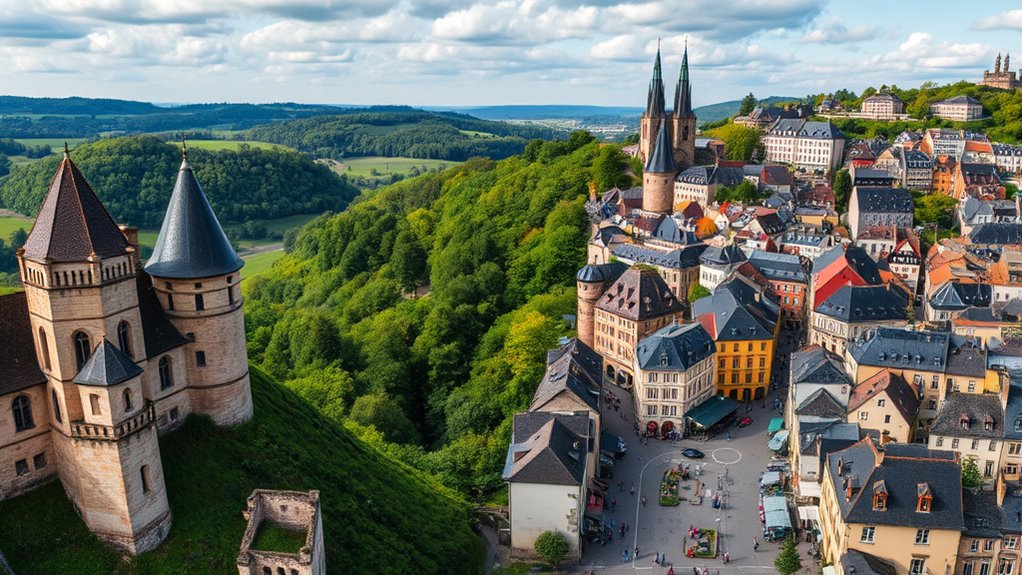
You see, Luxembourg’s fight for independence became clearer after the 1839 Treaty of London, which recognized its full sovereignty. The 1867 Neutrality Guarantee further secured its independence and prevented future invasions. When the personal union with the Netherlands ended in 1890, Luxembourg gained full control over its government and destiny. Incorporating traditional symbols of national identity helped solidify its sovereignty and cultural independence.
Treaty of London (1839)
How did Luxembourg secure its independence amidst regional conflicts and shifting European politics? The 1839 Treaty of London played a crucial role. After disputes between Belgium and the Netherlands over the region, this treaty recognized Luxembourg as a fully independent and neutral state. It divided the country, giving the western part to Belgium and confirming the eastern part as Luxembourg’s territory. The treaty also guaranteed Luxembourg’s neutrality and prevented military occupation. This agreement was essential because it protected Luxembourg from invasion and external domination during turbulent times. By establishing clear borders and a commitment to neutrality, the treaty laid the foundation for Luxembourg’s sovereignty. It helped the country navigate regional conflicts and European power struggles, securing its path toward independence and stability.
1867 Neutrality Guarantee
Luxembourg’s quest for sovereignty was shaped by its strategic position and the pressures of regional power struggles, making the guarantee of its neutrality essential for survival. After decades of conflict and occupation, Luxembourg sought stability through international recognition of its independence. The 1867 Treaty of London formalized this, declaring Luxembourg’s neutrality as a core principle. This neutrality aimed to prevent future invasions and secure its sovereignty amid European tensions. However, maintaining this status proved challenging, as both World Wars demonstrated. Despite violations, Luxembourg continued to defend its independence, relying on diplomatic efforts and international treaties. The neutrality guarantee became a cornerstone of its national identity, shaping policies and alliances that sought to preserve its sovereignty amid shifting regional dynamics. Recognizing the importance of international agreements in maintaining its neutrality and sovereignty, Luxembourg actively engaged in diplomatic negotiations to reinforce its status.
End of Personal Union
The end of the personal union between Luxembourg and the Netherlands in 1890 marked a pivotal turning point in your country’s quest for sovereignty. This separation allowed Luxembourg to establish its own monarchy under the House of Nassau, strengthening its independence. Additionally, the shift fostered independent governance, enabling Luxembourg to pursue its own political and economic policies. To understand its significance:
- Luxembourg gained full political autonomy, no longer linked to Dutch rulers.
- It paved the way for international recognition of its sovereignty.
- It helped solidify Luxembourg’s identity as a distinct nation-state.
This shift fueled Luxembourg’s efforts to assert control over its affairs, leading to its independence from external influence. It also set the foundation for future European integration and national development, marking a vital step in its journey toward modern sovereignty.
Luxembourg Through the Wars: Occupation and Liberation
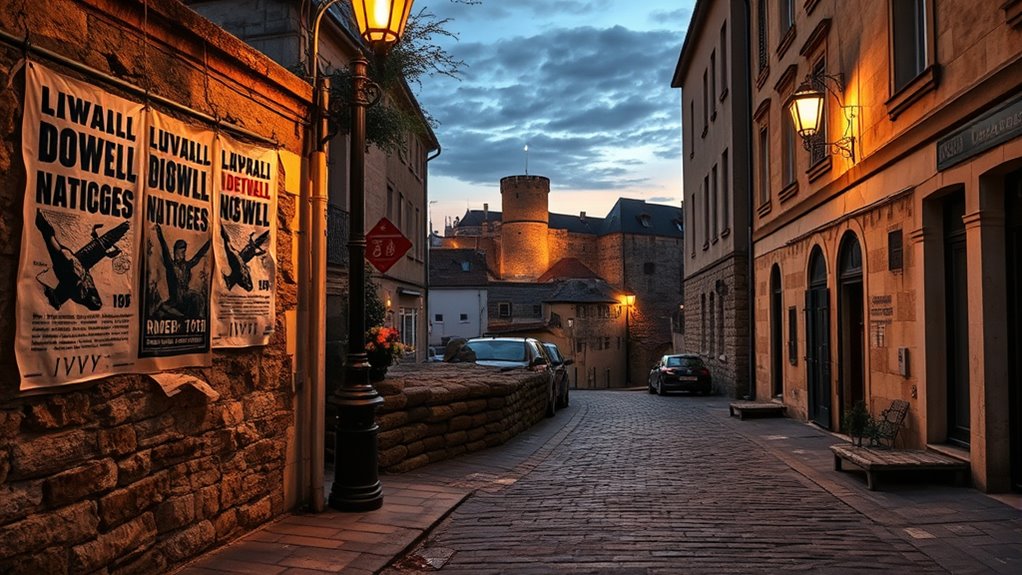
During both World War I and World War II, Luxembourg found itself caught in the turbulent crossfire of European conflicts, as invading forces violated its neutrality and occupied its territory. In WWI, German forces invaded, occupying the country from 1914 to 1918, causing social unrest and loss of life. During WWII, Nazi Germany again occupied Luxembourg from 1940 to 1944, annexing it into the Reich. You witness the hardships faced by your fellow Luxembourgers, including forced labor and repression. The Battle of the Bulge in late 1944 marks your country’s liberation by the US Army, bringing relief but leaving scars. These occupations deeply impact your nation’s identity, fueling resilience and a determination to defend independence and sovereignty in the future. Additionally, the experience of occupation strengthened the collective resolve to preserve national heritage and sovereignty.
Cultural Heritage and Architectural Landmarks

Cultural heritage in Luxembourg is vividly reflected through its historic buildings and landmarks that tell the story of its rich past. You’ll notice structures that showcase different eras, from medieval fortifications to modern architecture. These sites serve as tangible symbols of architectural evolution, illustrating how design has adapted over time to reflect changing cultural values. 1. The Adolphe Bridge, completed in 1903, symbolizes Luxembourg’s engineering prowess and resilience. 2. The Cercle Municipal, built in 1910, highlights early 20th-century elegance and civic pride. 3. The Gëlle Fra war memorial, erected in 1923, stands as a powerful symbol of national memory and independence. These landmarks not only reflect Luxembourg’s architectural evolution but also embody its cultural identity and historical milestones. As you explore, you’ll see how each site preserves stories of resilience, unity, and national pride that shape Luxembourg’s vibrant heritage today.
Legends and Mythology Shaping National Identity
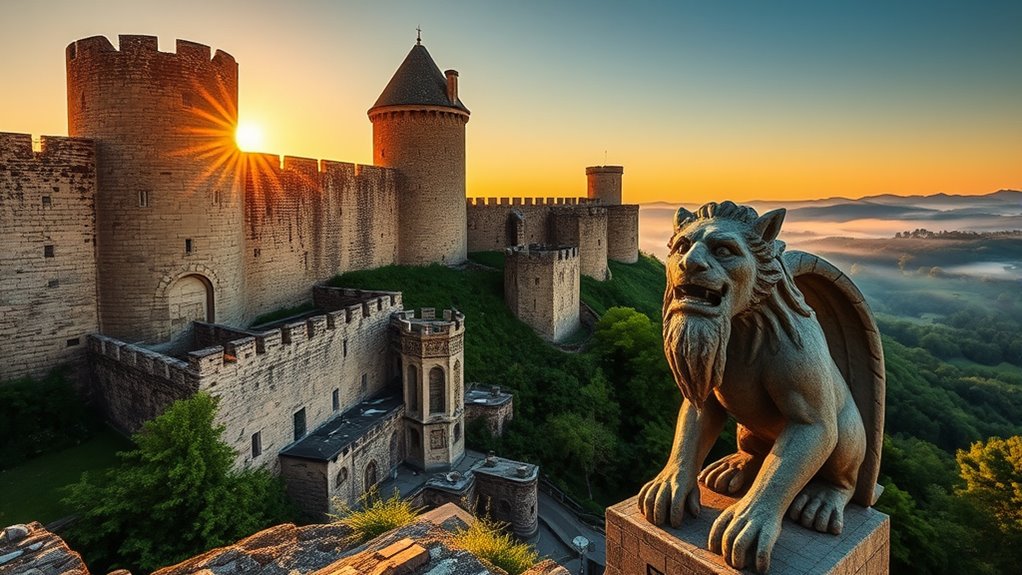
You can see how legends like Melusina and the myth of Count Siegfried influence Luxembourg’s identity by connecting history with imagination. These stories embody the country’s cultural roots and collective values. Exploring their significance reveals how myths continue to shape Luxembourg’s sense of self today. Additionally, understanding the cultural heritage behind these legends helps preserve their relevance for future generations.
Legend of Melusina
Have you ever wondered how legends shape a nation’s identity? The Legend of Melusina is a engaging story that reflects Luxembourg’s cultural roots. It tells of a mermaid princess who married Count Siegfried, promising to reveal her tail only on one day each year. You’ll learn about her secret, her tragic love story, and her role in shaping the land’s history. To understand its significance, consider:
- How Melusina symbolizes the connection between land and water.
- Its influence on local art, folklore, and traditions.
- The legend’s role in fostering a unique national identity.
This myth embodies themes of loyalty, mystery, and transformation—elements that continue to inspire Luxembourg’s cultural landscape and collective memory. It’s a story that ties the country’s past to its present.
Count Siegfried’s Myth
Count Siegfried’s myth has long been a cornerstone of Luxembourg’s national identity, blending history with legend to create a powerful symbol of strength and heroism. You learn that Siegfried, a legendary hero, is credited with founding Luxembourg, capturing the imagination through stories of bravery and conquest. His story involves slaying a dragon, gaining wisdom, and establishing the fortress of Lucilinburhuc, which became Luxembourg City. This myth reinforces ideas of resilience and noble origins, shaping how Luxembourgers see themselves. The legend of Siegfried also intertwines with cultural symbols like the lion and the shield, emphasizing courage and protection. Over time, this myth has been embraced as a unifying narrative, fostering pride and a sense of shared heritage among the people of Luxembourg.
Cultural Significance of Myths
Why do myths and legends hold such power in shaping a nation’s identity? They connect you to your roots, embody shared values, and create a sense of pride. In Luxembourg, stories like that of Melusina, the mermaid linked to Count Siegfried, serve as cultural symbols that unify people. These myths highlight the country’s origins, resilience, and unique character. Here are three ways myths influence Luxembourg’s identity:
- Preserving Heritage: They keep history alive and foster cultural continuity.
- Building Pride: Legends reinforce a sense of belonging and national pride.
- Shaping Values: Myths reflect core virtues like resilience and unity, guiding societal norms.
Through these stories, you see how mythology shapes Luxembourg’s national character and keeps its history meaningful today.
Economic Transformation From Agriculture to Industry

Luxembourg’s economic transformation from agriculture to industry began in the 19th century, driven by strategic trade policies and infrastructure development. You see, joining the Prussian Zollverein in 1842 opened new markets and boosted economic growth, even with initial political hesitations. The expansion of railway networks and road systems further integrated the country into regional trade, making it easier to move goods and resources. During this period, traditional farming gave way to manufacturing industries, especially steel production, which became central to the economy. As industries grew, Luxembourg attracted investments and labor from neighboring countries. The development of infrastructure like airports and modern roads in the early 20th century reinforced this shift, setting the stage for Luxembourg’s industrial prominence and economic modernization.
Infrastructure Growth and Modern Development

As Luxembourg shifted from an agriculture-based economy to an industrial powerhouse in the 19th century, the country recognized the importance of developing its infrastructure to support this growth. You’ll notice key advancements that fueled modernization:
- The expansion of railway networks connected Luxembourg to neighboring countries, boosting trade and mobility.
- The construction of airports, like Sandweiler Airport in the 1930s, facilitated international connections.
- Road networks improved considerably, integrating surrounding communities and easing transportation within the country.
These developments laid the foundation for Luxembourg’s modern economy. They also supported urban growth, especially in Luxembourg City, where iconic structures like Villa Louvigny and rebuilt railway stations symbolize progress. This infrastructure evolution helped position Luxembourg as a crucial hub in Europe.
Political Evolution and European Integration
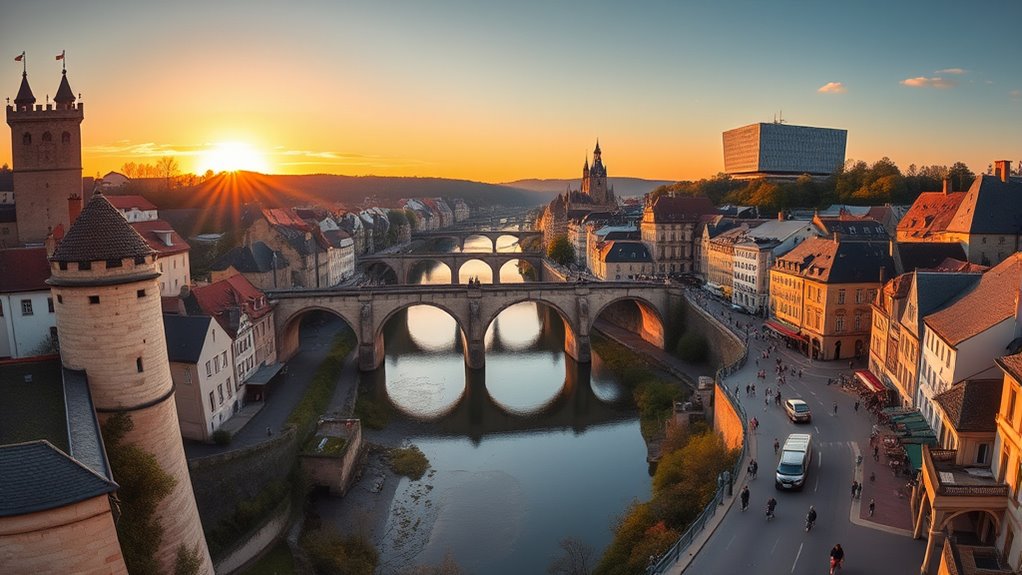
Have you ever wondered how Luxembourg transformed from a neutral monarchy into a key player in Europe’s political landscape? You see, after declaring independence, Luxembourg’s neutrality was recognized in 1867, but it was tested during the two World Wars. Despite these challenges, the country embraced deeper European integration, becoming a founding member of the European Economic Community in 1957. This move signaled its commitment to cooperation and peace. Leaders like Pierre Werner and Jacques Santer helped shape a modern, stable democracy that balances sovereignty with international engagement. Today, Luxembourg actively participates in the European Union, NATO, and other international organizations, cementing its role as a crucial connector in Europe’s political fabric. Its evolution reflects resilience and a dedication to unity and stability.
Notable Figures and Their Impact on Luxembourg’s Identity
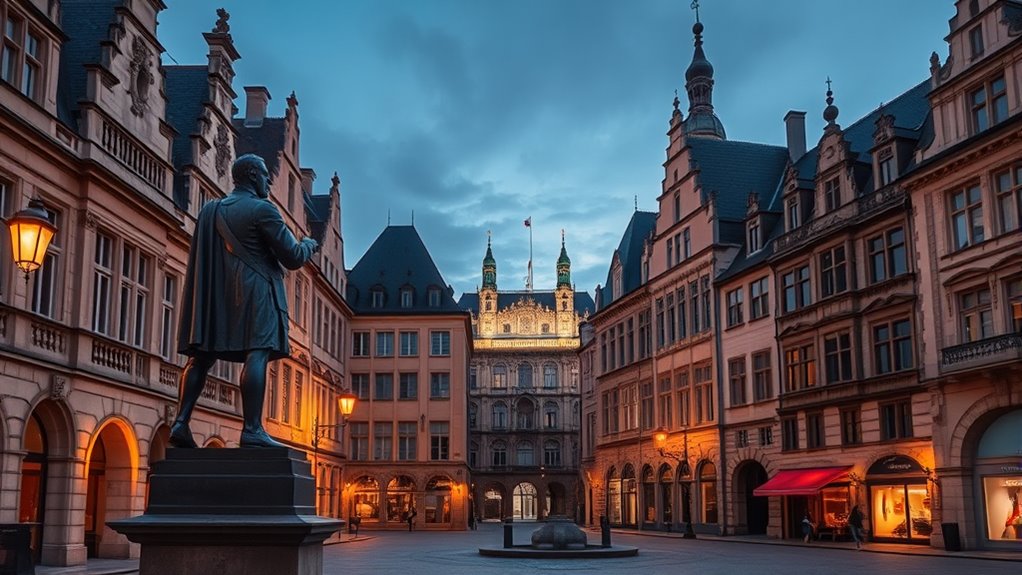
Throughout its modern history, certain individuals have profoundly shaped Luxembourg’s national identity and international reputation. Your awareness of these figures reveals how their actions and legacies continue to define the country today.
- Grand Duke Charlotte – Modernized Luxembourg’s monarchy, fostering stability and national pride after WWII.
- Pierre Werner – Architect of economic integration, he led Luxembourg into the European Economic Community, shaping its role in Europe.
- Victor Hugo – His visits and writings helped elevate Luxembourg’s cultural profile and linked it to broader European intellectual currents.
These figures exemplify how leadership, diplomacy, and cultural influence have forged Luxembourg’s resilient identity, blending tradition with European integration. Their impact remains central to the country’s sense of pride and international standing.
Frequently Asked Questions
How Did Luxembourg’s Location Influence Its Medieval Strategic Importance?
Your location by the rivers Alzette and its position on key trade routes made Luxembourg highly strategic during medieval times. You benefit from control over important crossings and access between larger European regions. This position allowed you to serve as a crucial hub for commerce and military defense. Your natural defenses, combined with your proximity to major routes, boosted your importance in regional politics, trade, and military strategies.
What Role Did Luxembourg Play in the Formation of the European Union?
You play a crucial role in the formation of the European Union because Luxembourg was a founding member of the European Economic Community in 1957. Its leaders actively promoted economic cooperation and political integration, helping shape the EU’s development. Luxembourg’s commitment to unity, along with its strategic position and diplomatic efforts, made it a key player in advancing European integration, fostering peace, stability, and prosperity across the continent.
How Has Luxembourg’s Cultural Identity Evolved Post-World War II?
You see, Luxembourg’s cultural identity has grown stronger after World War II, proving that “what doesn’t kill you makes you stronger.” You’ve embraced your rich heritage, blending French, German, and local traditions into a unique identity. The country emphasizes multiculturalism, arts, and language diversity, fostering pride. You’ve also become more outward-looking, actively participating in European cooperation, shaping a modern, resilient culture rooted in history but open to the future.
In What Ways Did the Luxembourg Crisis of 1867 Affect Its Independence?
The Luxembourg Crisis of 1867 solidified your country’s independence by guaranteeing its neutrality and sovereignty through the Treaty of London. You see, the crisis led to the dismantling of Luxembourg’s fortress walls and the withdrawal of Prussian troops, preventing further occupation. This event reinforced your country’s status as a fully independent nation, allowing you to maintain control over your territory and shape your future without external interference.
What Are the Origins of Luxembourg’s Most Famous Legends and Myths?
You might find the legend of Melusina fascinating, as it symbolizes Luxembourg’s mythic origins. This myth likely arose from medieval stories blending local folklore and European fairy tales, emphasizing themes of transformation and hidden secrets. Imagine a noblewoman who transforms into a mermaid, reflecting the mysterious landscape and history of Luxembourg’s rocky terrains. Such myths serve to connect people to their land, creating a shared identity rooted in legend and tradition.
Conclusion
You’ve explored Luxembourg’s rich history, from its foundational feats to its fierce fight for freedom. Its cultural charm, enthralling castles, and continued climb in commerce showcase a country that’s constantly crafted through courage and commitment. As you now know, Luxembourg’s legacy lives in its landmarks, leadership, and lasting love for liberty. So, embrace its enduring essence, celebrate its history, and carry its story forward with pride and passion.


